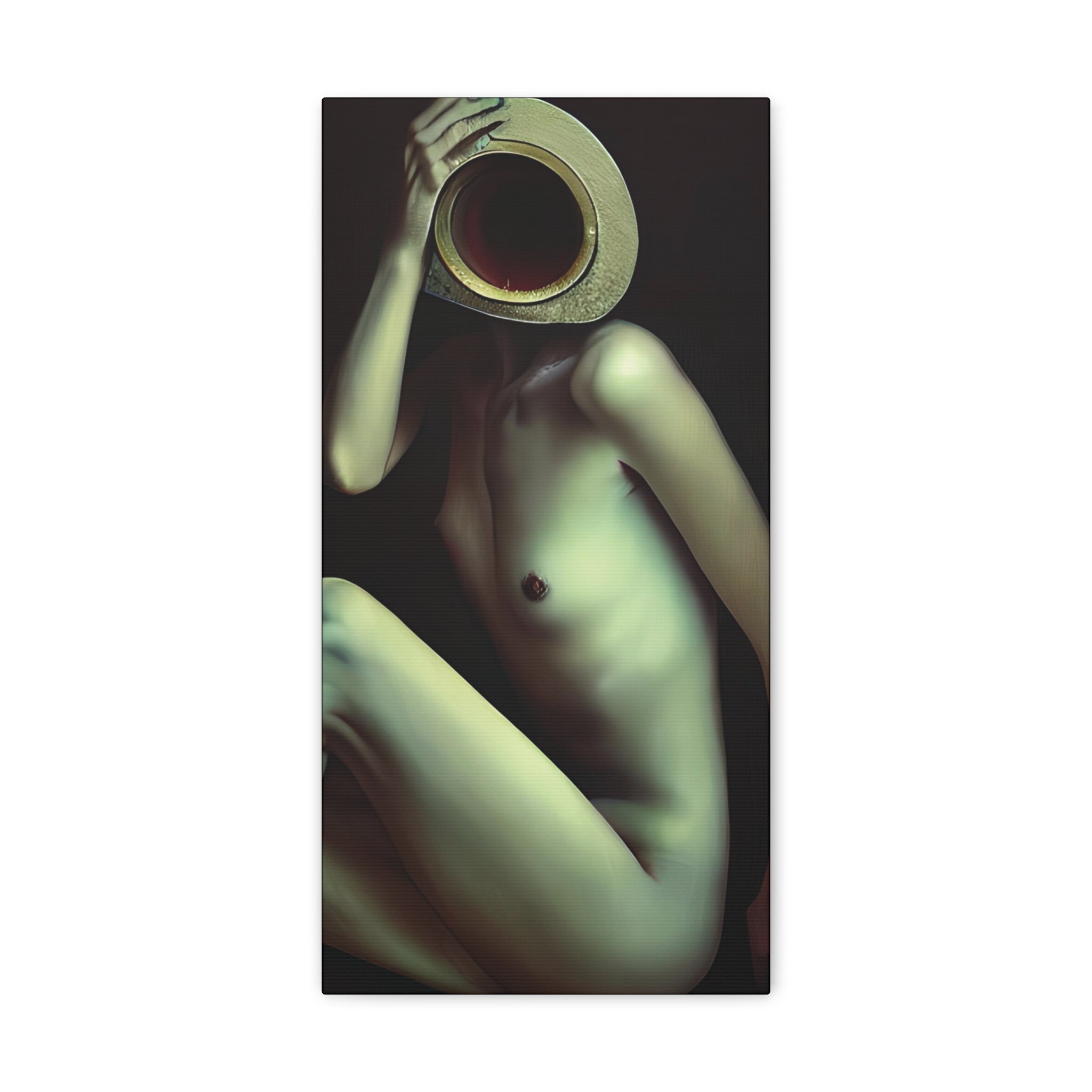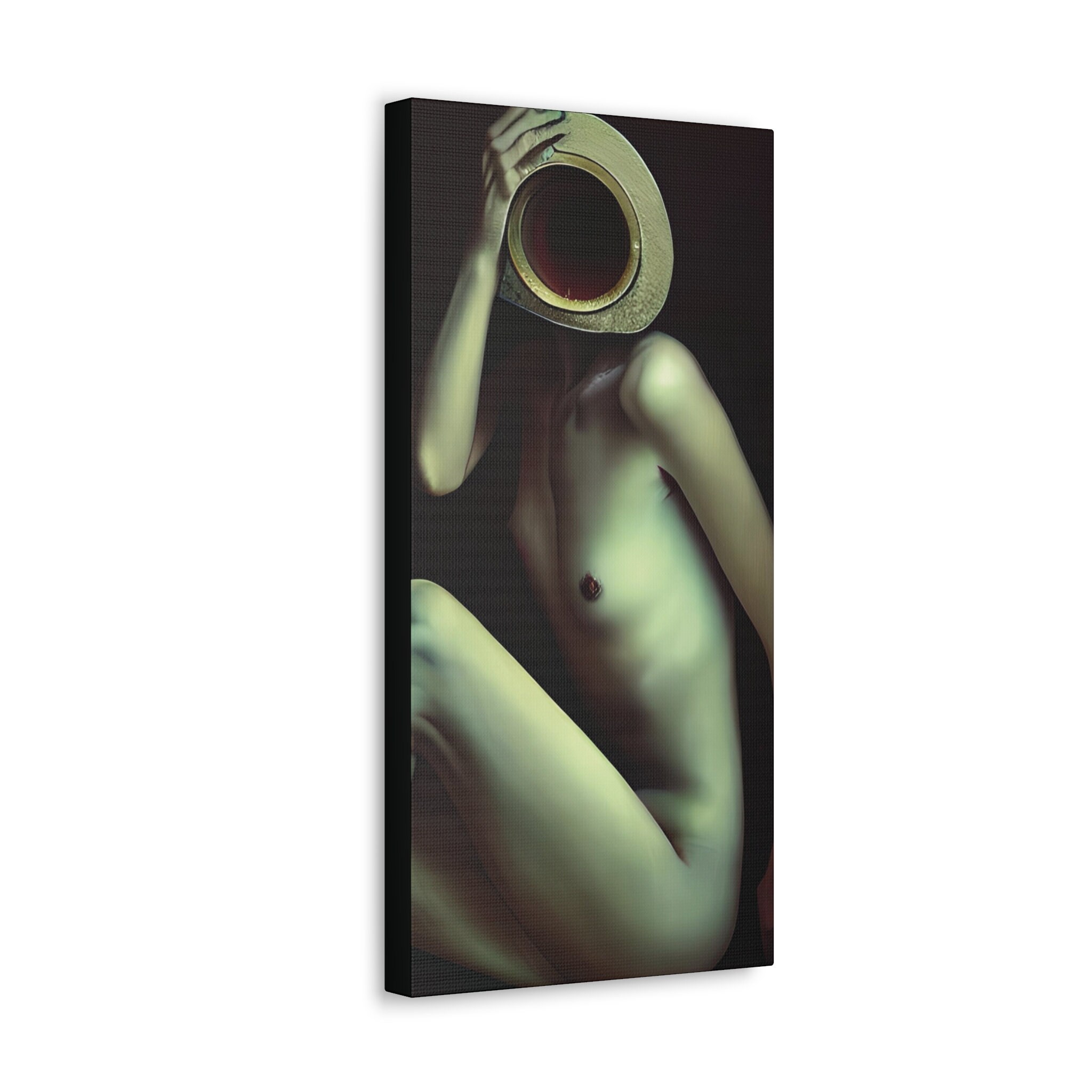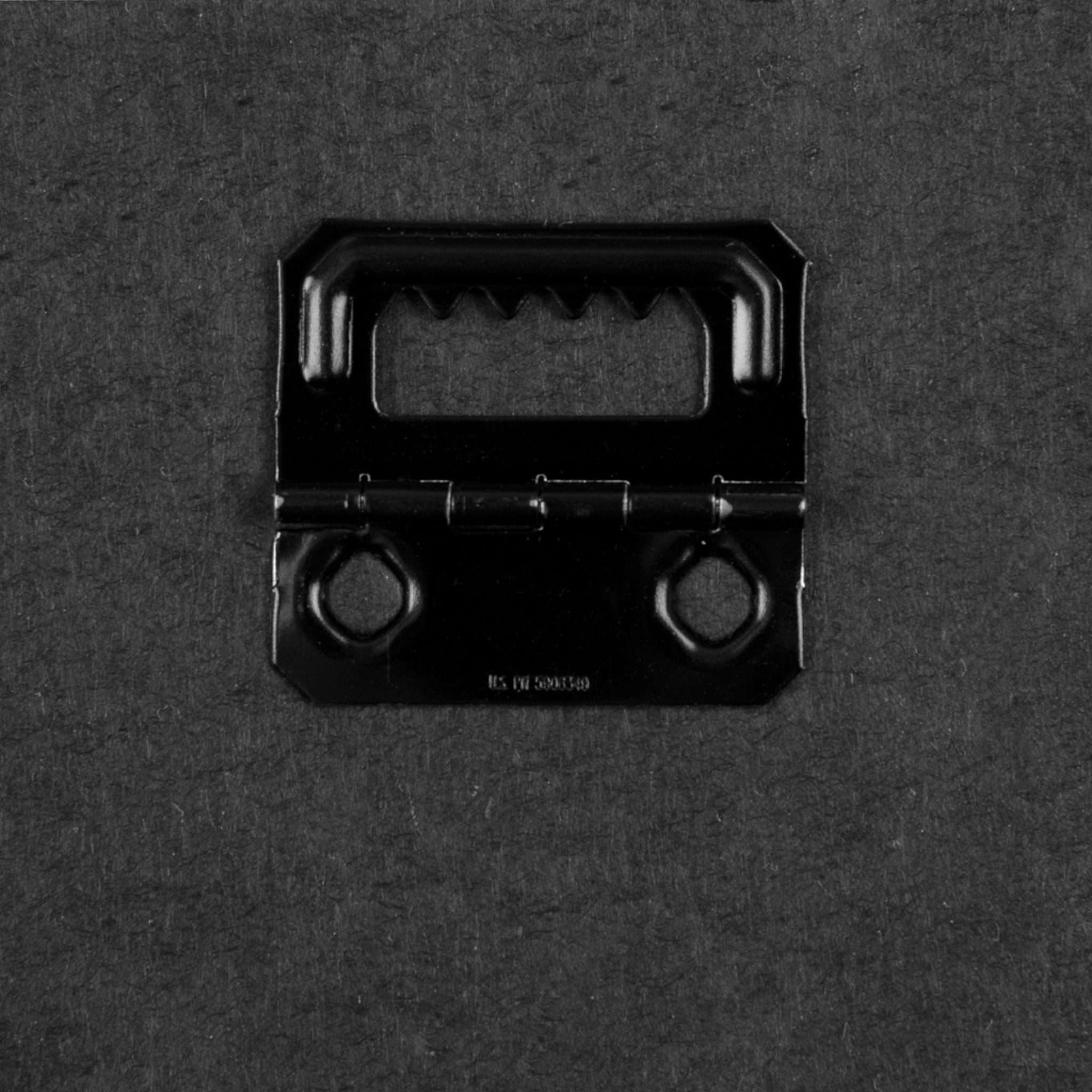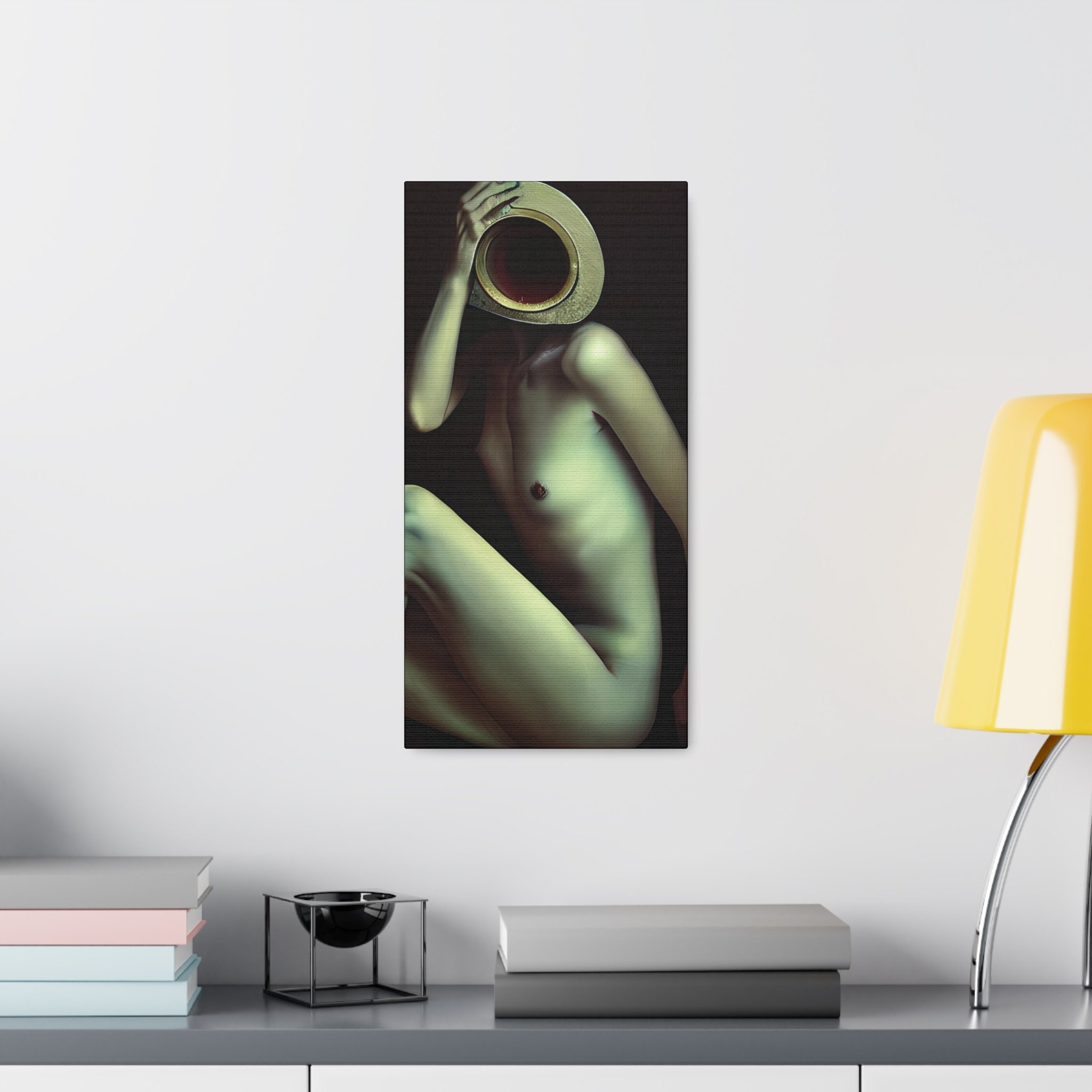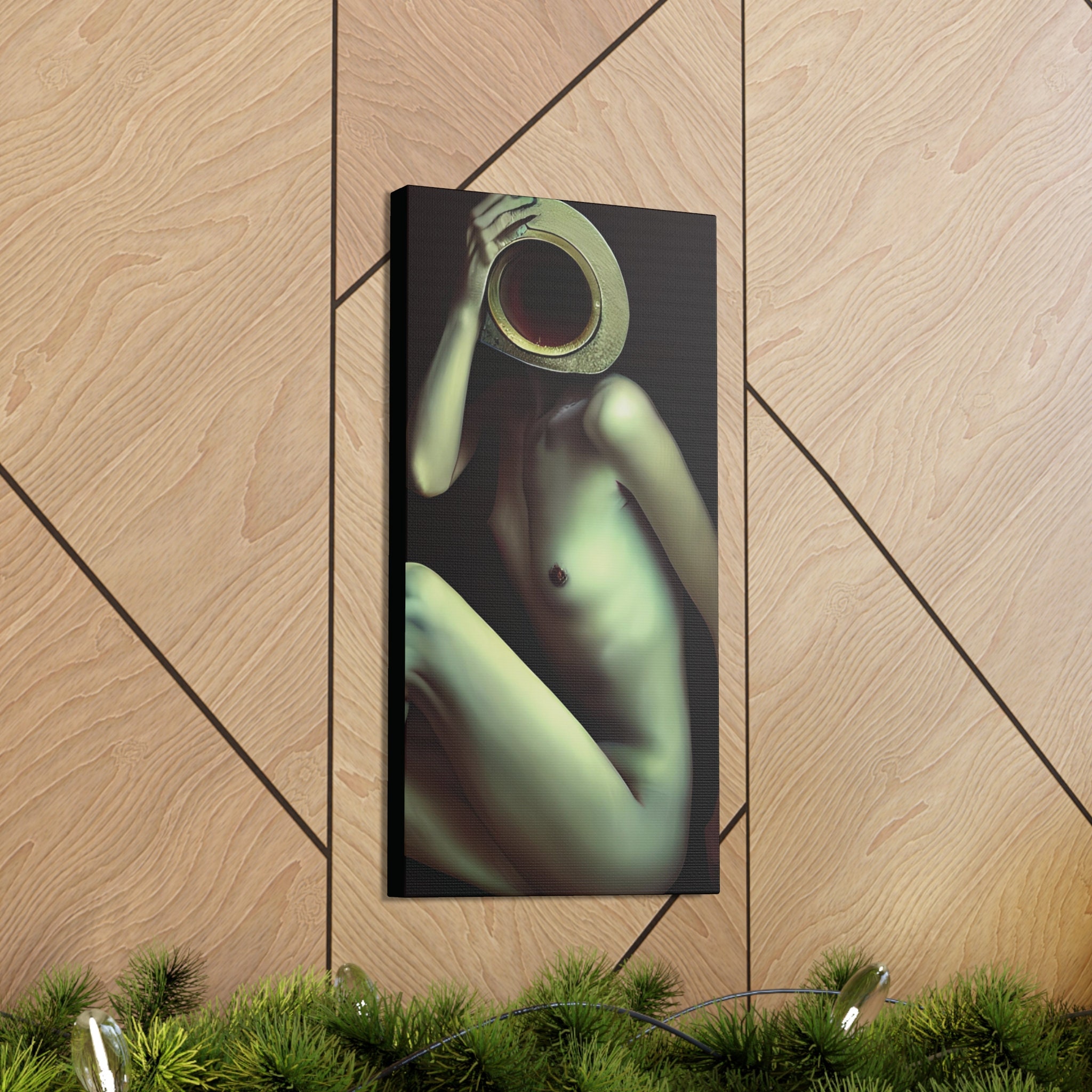Reflections of the Absent Self, Canvas Print, 10"x20", Introspection, Personal Discovery, Humanity, Identity, True Self, Enlightenment
$70.00
Limited time only! 15% off Discount Code for this listing: ORIGINALART15OFF
Many of the canvases in my shop are also available as high-quality posters, both framed and unframed. Please contact me for details.
"Reflections of the Absent Self" commands attention and introspection. This paintinng transcends traditional boundaries, delving into the depths of surrealism and the subconscious. It portrays a nude figure in repose, the sinuous lines of the body depicted with an almost ethereal glow against the dark backdrop. The figure's pose is relaxed yet deliberate, creating a sense of intimacy and vulnerability as the viewer is invited into a personal moment of reflection.
Central to the composition is a large, gold-framed circular object where the head should be. Is the figure's head behind it or has the object replaced the head? Its resemblance to a mirror is undeniable, yet it is paradoxically devoid of reflection, partially filled instead with a profound red mist, within a dark abyss. The absence of a reflection is a poignant departure from the mirror's traditional role as a revealer of truths, instead suggesting a void, a space ripe with potential for personal discovery or an indication of an identity that is yet to be realized or is fundamentally unknowable.
The stark nudity of the figure is emblematic of the human condition, stripped of societal constructs, standing—or rather sitting—in a state of pure existence. This nudity can be perceived not as a physical vulnerability but as a metaphorical one, where all pretenses are cast aside, and the essence of the self is laid bare. The absence of clothing further removes any indication of social status, cultural identity, or time period, pushing the viewer to consider the figure not as a person from a specific context but as a representation of humanity in its most universal aspect.
Notably, the figure's face, the usual locus of identity and emotion, is obscured by the circular object. This act of concealment raises questions about the nature of identity itself. Is our true self-hidden from the eyes of others, or do we even possess a stable, coherent self that can be reflected and understood? Shielding the face from view denies the audience the immediate grasp of personality usually gleaned from facial expressions and features. It forces a confrontation with the anonymous, and often uncomfortable, elements of our psyche—the parts we choose not to reveal or perhaps do not even acknowledge.
The use of color and light in "Reflections of the Absent Self" is instrumental in crafting its enigmatic atmosphere. The figure is illuminated with an almost otherworldly light, a glow that seems to emanate from within rather than from an external source. This illumination is symbolic of the notion that understanding and enlightenment come from within rather than from external validations. Conversely, the surrounding darkness represents the unknown, the parts of our psyche that remain unexplored.
In conclusion, "Reflections of the Absent Self" is a profound commentary on the human experience. It challenges the viewer to confront the fluidity of identity and the elusive nature of the self. The artwork does not offer answers but instead invites a dialogue with the innermost recesses of the mind, prompting a personal quest for meaning and understanding in the vast canvas of human existence. Through its evocative symbolism and compelling aesthetic, the piece becomes a timeless exploration of what it means to look within and beyond the surface.
A perfect addition to every room! This canvas is made from a finely textured artist-grade cotton substrate which consistently reproduces image details with outstanding clarity and detail.
Sizes:
• 10" wide x 20" high
Canvas specs:
• Material: Ultra smooth, 100% cotton rag canvas
• Material quality: Finely textured artist-grade cotton substrate
• Surface finish: Matte
• Cotton rag fabric weight: 400 GSM (11.80 oz/y²)
Wrapped canvas frame specs:
• Wrapped canvas frame thickness: 1.25"
• Framing quality: Beautifully finished, taut corners that give a clean and crisp look
• Hanging hardware: Attached
Ink specs:
• Canon 12-color Aqueous ink
• Acid free, archival quality
Shipping from United States
Processing time
1-7 business days
Customs and import taxes
Buyers are responsible for any customs and import taxes that may apply. I'm not responsible for delays due to customs.
Payment Options
Returns & Exchanges
I gladly accept returns and exchanges
Just contact me within: 14 days of delivery
Ship items back to me within: 30 days of delivery
I don't accept cancellations
But please contact me if you have any problems with your order.
The following items can't be returned or exchanged
Because of the nature of these items, unless they arrive damaged or defective, I can't accept returns for:
- Custom or personalized orders
- Perishable products (like food or flowers)
- Digital downloads
- Intimate items (for health/hygiene reasons)
Conditions of return
Buyers are responsible for return shipping costs. If the item is not returned in its original condition, the buyer is responsible for any loss in value.
Frequently Asked Questions
What is All-Over-Print (AOP)?
All-Over Print (AOP) is a printing method that uses dye-sublimation to print a design onto polyester. During the dye sublimation process the dye is absorbed into the fabric. Since, it is not printed on the surface, like most t-shirts, it provides for a fantastic soft-to-the-touch feel and superior breathability.
AOP is a more time consuming method than screen printing or direct-to-garment (DTG) printing, so the prices are higher and the production times are longer, but the results are most definitely worth it.
Advantages of AOP:
The design won't peel off, unlike typical screen printing.
The design is part of the fabric of the item, so it will last as long as the item does.
The intensity of color is often unmatched.
What is Giclée?
Giclée (pronounced zhee-CLAY or often gee-CLAY) is a printing process that creates a museum quality, archival print. Special acid-free, paper is printed with fade resistant ink using a state-of-the-art, large format inkjet printer.
What is a gallery wrap canvas?
Gallery wrap is a style of displaying a canvas that doesn't show any visible staples or nails holding the fabric to the wooden stretcher bars. This style of canvas is intended to be hung unframed.
What is a gallery mirror wrap canvas?
Mirrored edges (mirror wrap) is used to show the whole image on the main surface, rather than printing the edges of the image on the sides (image wrap) of the canvas frame. It is usually used when there is necessary detail on the edges of the image. Image wrap is used when the focal point of the image is in the center.
